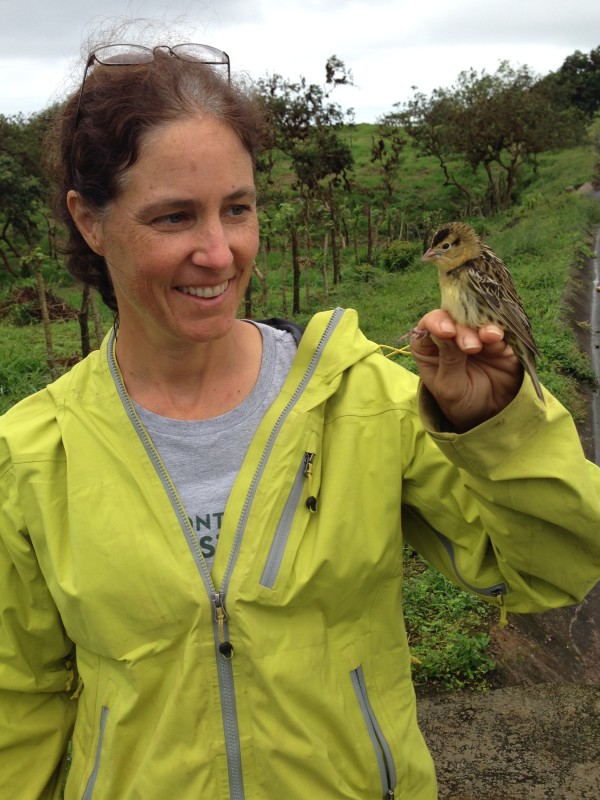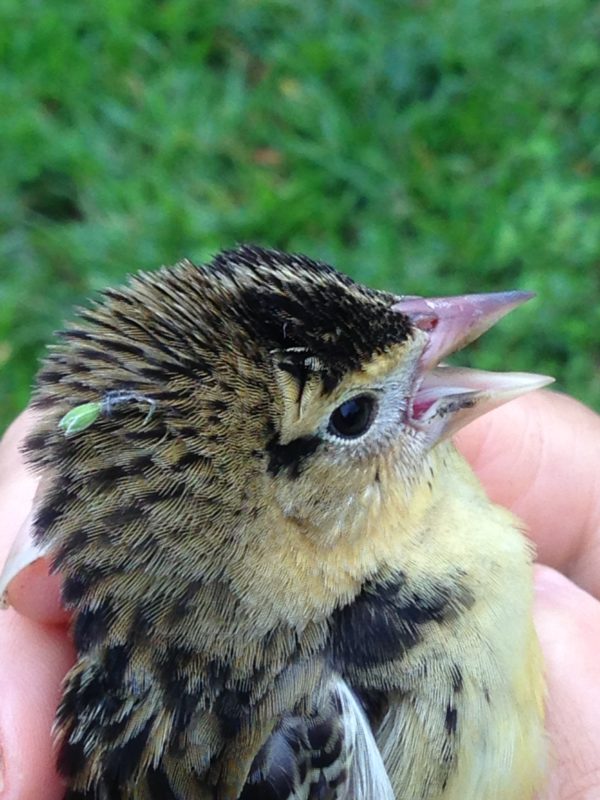
Roz Renfrew holds a Bobolink she captured in the Galapagos.
What on earth are Bobolinks doing in the Galapagos? Historic records, beginning with those of Charles Darwin, document the extremely limited but regular presence of this migratory grassland bird on the islands, most frequently in the fall. Each year a few Bobolinks (perhaps a few dozen, we don’t really know), stop there during their >10,000 km southbound migration from North American grasslands to wintering grounds in Bolivia and Argentina. What we know about this migratory stopover is limited to a spattering of records that merely document their existence on the islands.
In a somewhat risky mission to find out more, I joined Dr. Noah Perlut of the University of New England and volunteer Jen Megyesi on the island of San Cristóbal in an attempt to intercept migrating Bobolinks. Our discoveries were published recently in the Wilson Journal of Ornithology, a peer-reviewed journal. This study is the first to describe the species’ habitat and behavior, its body condition between two long transoceanic journeys, and its potential as a vector of an invasive plant.
The few Bobolinks that stop in the Galapagos, 2,000 – 3,000 km west of the main migration route, are a sheer spectacle of flight. They must fly over the Pacific before and after this island stopover, a transoceanic journey totaling some 2,500 km or more. The Galapagos is a critical refueling pit stop, when their diet is mostly seed.
Our risky investment paid off. We found, watched, captured, and measured Bobolinks. We only set our eyes on about a dozen individuals in total, in grasslands with characteristics similar to those where they breed. To my surprise, we didn’t see them where seed was most abundant. Instead, they were feeding in the largest and most open of the limited grasslands, at the highest elevation on the island. The few groups of three to five individuals we watched over the course of 12 days were never in short, heavily grazed pastures, but in taller grasslands with more variable vegetation structure.
The body condition of the nine birds we managed to (painstakingly) capture ran the gamut from emaciated to plump. One bird was so starved that we were able to walk right up to it as it foraged for seed. Their weights ranged from a starved 22.5g to a fat 40g bird.
We noticed that several of the birds had one or two seeds with long, sticky spines weaved into their feathers, usually on the belly. The seeds were so firmly embedded that we were unable to pull them off the birds. They belonged to a plant species native to the Galapagos, but highly invasive on the South American mainland. A botanist tells us that the spine and seed dry out over time, making it less likely that they could remain on the birds during their flight to the mainland; however, the potential exists for Bobolinks to serve as a dispersal vector. Bobolinks may also serve as vectors of avian malaria, as blood samples we collected would later prove (stay tuned for that journal paper).

A seed hitching a ride on a Bobolink’s head in the Galapagos.
Our next mission is to use their DNA from the blood samples to try to figure out just where these birds came from, and whether they are true mavericks of the Bobolink world. Perhaps they belong to an isolated breeding population in western North America, or perhaps there are a few birds from various breeding locations that go off the usual migratory flight course each year. The answer will provide insight into how some lineages of avian malaria are carried to the Galapagos, and has implications for how to manage transmission to endemic birds.

This is a fascinating article and a surprising discovery of the migratory routes of bobolinks.
Excellent intel. Thank you for publishing it. I’m curious about Bobolink occurrence on the other islands in the archipelago?
And thank you for reading it! There are historical records of Bobolinks on some of the other islands, but we did not search any of the other islands during our stay.